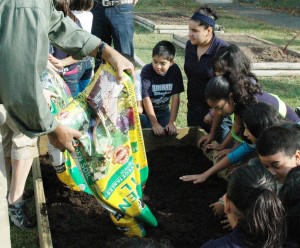Farm & Ranch
AgriLife Extension’s Texas Grow! Eat! Go! program receives top award for diversity

By: Paul Schattenberg
COLLEGE STATION – The Texas Grow! Eat! Go! program of the Texas A&M AgriLife Extension Service has received the National Extension Diversity Award from Cooperative Extension and the U.S. Department of Agriculture’s National Institute of Food and Agriculture.
The Texas Grow! Eat! Go! program has received a top award for diversity from the U.S. Department of Agriculture — National Institute of Food and Agriculture a national Cooperative Extension association. (Texas A&M AgriLife Extension Service graphic)
The program is a five-year collaboration among AgriLife Extension, the University of Texas School of Public Health, Texas A&M University and the Texas A&M Health Science Center School of Public Health. The goal is to improve the physical activity and eating behaviors of children and families, especially in low-income and underserved areas.
The award will be presented during the annual meeting of the Association of Public and Land-grant Universities Nov. 15-17 in Indianapolis.
According to the USDA-NIFA, the National Diversity Award recognizes an Extension program exhibiting significant contributions and accomplishments in achieving and sustaining diversity and pluralism.
“The primary goal of the program is to help combat youth obesity by reversing unhealthy weight trends and influencing youth to develop better eating habits,” said Dr. Susan Ballabina, AgriLife Extension associate director for program development, College Station.
The Texas Grow! Eat! Go! program is currently being implemented at 32 Title I elementary schools in four counties. Those providing program support include AgriLife Extension agents for horticulture, family and consumer sciences, urban youth development and 4-H youth development, as well as employees of the agency’s Expanded Food and Nutrition Education and Better Living for Texans programs, and the Prairie View A&M Cooperative Extension Program. It is also supported by volunteers from the agency’s Master Gardener and Master Wellness programs and by parent volunteers recruited by the schools.
“Currently we present the program primarily in Title 1 urban elementary schools with a high degree of ethnic diversity,” Ballabina said. “Youth enrollment in the program is 46 percent Hispanic and 25 percent African-American, with 44 percent of the participants indicating some degree of family food insecurity.”
Ballabina said the problem of child obesity is particularly acute in Texas where one in three children and nearly half of Hispanic children are overweight or obese.
She said the program has been successful as the result of marshaling various AgriLife Extension resources and programs focused on improving nutrition and physical activity.
“The agency’s Junior Master Gardener and Walk Across Texas programs have been particularly involved in this initiative,” she said. “The JMG program is a youth gardening program designed to ignite a passion for learning, success and service through gardening.
Youth gardening is one of the activities emphasized by the Texas Grow! Eat! Go! program. (Texas A&M AgriLife Extension Service photo by Paul Schattenberg)
“And Learn! Grow! Eat! and Go! is a new research-based, curriculum spin-off project of the International Junior Master Gardener program that combines academic achievement, gardening, nutritious food experiences, physical activity, and school and family engagement. Walk Across Texas is a statewide eight-week community-based physical activity program that uses friendly competition to help get people moving.”
Ballabina said the program has produced a significant change in participating children trying, consuming and choosing vegetables, increasing physical activity, decreasing the time on the computer or watching television, and improving the availability of fresh fruits and vegetables in the home.
“Obesity rates fell from 57 percent before intervention to 39 percent post-intervention,” she noted.
Ballabina said the program is now being introduced across Texas and nationwide through train-the-trainer workshops and a bilingual “Learn! Grow! Eat! Go!” curriculum available through the international Junior Master Gardener network, http://jmgkids.us/LGEG.
“This program is an example of the importance and efficacy of bringing AgriLife Extension instruction and information to the community,” she said. “Through the synergy of various agency personnel working together toward a common goal under the Grow! Eat Go! banner, we have been able to make a significant impact on improving the health and quality of life for hundreds of young people in this state.”
-30-
Find more stories, photos, videos and audio at http://today.agrilife.org
Farm & Ranch
Hazards of Backyard Poultry

By Barry Whitworth, DVM
Having backyard poultry is a popular agriculture enterprise. According to the United States Department of Agriculture, 0.8 percent of all households in the United States have chickens. People keep chickens for a variety of reasons with table eggs being one of the more common reasons.
Unfortunately, some of these poultry producers are not aware of the hazards that come with keeping poultry because many times they carry pathogens but appear healthy.
Chickens are carriers of several zoonotic diseases. These are diseases that can be passed from animals to humans. According to a recent survey in Pennsylvania, a majority of backyard poultry producers were aware of the dangers of avian influenza. However, this study also revealed that far fewer producers were aware of the risk of possible exposure to Salmonella and Campylobacter.
The lack of knowledge about the hazards of raising poultry likely contributes to the continued issues of Salmonella outbreaks associated with backyard poultry. In 2023, the Centers for Disease Control and Prevention reported 1,072 illnesses of Salmonella linked to backyard poultry, and 272 of those patients required hospitalization. Oklahoma reported 43 individuals with the disease.
To read more, pick up a copy of the April issue of NTFR magazine. To subscribe by mail, call 940-872-5922.
Farm & Ranch
Ag Elsewhere: Wyoming

By Tressa Lawrence
Babies are tucked away in every nook and cranny. Many ranchers across Wyoming have baby animals popping up all over this time of year.
Farm & Ranch
Ag Elsewhere: Montana

By Lindsey Monk
Another load of grain in to keep feeding the calves until the green grass can really start popping.
-

 Country Lifestyles1 year ago
Country Lifestyles1 year agoScott & Stacey Schumacher: A Growth Mindset
-

 Equine7 months ago
Equine7 months agoThe Will to Win
-

 Country Lifestyles7 years ago
Country Lifestyles7 years agoStyle Your Profile – What your style cowboy hat says about you and new trends in 2017
-

 Country Lifestyles4 years ago
Country Lifestyles4 years agoAmber Crawford, Breakaway Roper
-

 HOME7 years ago
HOME7 years agoGrazing North Texas – Wilman Lovegrass
-

 Country Lifestyles7 years ago
Country Lifestyles7 years agoDecember 2016 Profile, Rusty Riddle – The Riddle Way
-

 Country Lifestyles8 years ago
Country Lifestyles8 years agoJune 2016 Profile – The man behind the mic: Bob Tallman
-

 Outdoor9 years ago
Outdoor9 years agoButtercup or Primrose?








